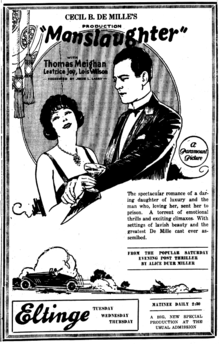Manslaughter (1922 film)
| Manslaughter | |
|---|---|
 The famous orgy scene from the film | |
| Directed by | Cecil B. DeMille |
| Produced by |
Cecil B. DeMille Jesse L. Lasky |
| Written by |
Jeanie MacPherson Alice Duer Miller (novel) |
| Starring | Leatrice Joy |
| Cinematography |
L. Guy Wilky Alvin Wyckoff |
| Edited by | Anne Bauchens |
Production company | |
| Distributed by | Paramount Pictures |
Release dates |
|
Running time |
100 minutes (10 reels; 9,061 feet) |
| Country | United States |
| Language |
Silent English intertitles |
| Budget | $385,000[1] |
Manslaughter is a 1922 American silent drama film directed by Cecil B. DeMille and starring Thomas Meighan, Leatrice Joy and Lois Wilson.
Plot

A wild, wealthy woman (Joy) is brought to heel by a sermonizing district attorney after she accidentally hits and kills a motorcycle cop.
Cast
- Leatrice Joy as Lydia Thorne
- Thomas Meighan as Daniel J. O'Bannon
- Lois Wilson as Evans (Lydia's maid)
- John Miltern as Gov. Stephan Albee
- George Fawcett as Judge Homans
- Julia Faye as Mrs. Drummond
- Edythe Chapman as Adeline Bennett
- Jack Mower as Drummond (policeman)
- Dorothy Cumming as Eleanor Bellington
- Casson Ferguson as Bobby Dorest
- Michael D. Moore as Dicky Evans (as Mickey Moore)
- James Neill as Butler
- Sylvia Ashton as Prison matron
- Raymond Hatton as Brown
- Mabel Van Buren as Prisoner
- Ethel Wales as Prisoner
- Dale Fuller as Prisoner
- Edward Martindel as Wiley
- Charles Ogle as Doctor
- Guy Oliver as Musician
- Shannon Day as Miss Santa Claus
- Lucien Littlefield as Witness
Production
According to Leatrice Joy, the filming of the car chase scene was extremely nerve-wracking because she herself had to drive the car, which had been fitted with a platform to support two cameramen and the director, plus equipment. Their safety depended entirely upon her skills as a motorist.[2] Joy did most of her own driving, though in some shots the car was driven by stunt double Leo Nomis.[3] During the shooting of a prison sequence, Joy burned her hand accidentally with soup in a prop cauldron; assistant director Cullen Tate had neglected to inform her that the soup was scalding hot.[2]
Preservation status
Prints of the film exist in the George Eastman House film archive, and in the Paul Killiam Collection.
Reaction
Manslaughter is thought of by historians as one of De Mille's lesser efforts as a director. Historian Kevin Brownlow notes that Joy and Wilson "both give far better performances than the film deserves."[4] "It is hard to believe that such a crude and unsubtle film could come from a veteran like De Mille," said a 1963 Theodore Huff Society program note for the film, "harder still to believe that this came from the same year that Orphans of the Storm, Down to the Sea in Ships", and Foolish Wives. The amateurish and crudely faked chase scenes that start the film are of less technical slickness than Sennett had been getting ten years earlier. Manslaughter is exactly the kind of picture that the unknowing regard as typical of the silent film - overwrought, pantomimically acted, written in the manner of a Victorian melodrama, the kind of film that invites laughter at it rather than with it."[4]
When a print was screened by William K. Everson for Joy's daughter's birthday, the star of the film attended and saw it for the first time in forty years. According to Kevin Brownlow, "Miss Joy thought it hilarious."[4]
References
- ↑ "Progressive Silent Film List: Manslaughter". Silent Era. Retrieved 2008-05-02.
- ↑ 2.0 2.1 Brownlow, K.; The parade's gone by...; University of California Press, 1976; p. 185
- ↑ http://www.imdb.com/title/tt0013372/fullcredits#cast
- ↑ 4.0 4.1 4.2 Brownlow, K.; The parade's gone by...; University of California Press, 1976; p. 184
External links
| Wikimedia Commons has media related to Manslaughter (1922 film). |
- Manslaughter at the Internet Movie Database
- Manslaughter (1922) at SilentEra
- Manslaughter at AllMovie
- Manslaughter is available for free download at the Internet Archive
- Manslaughter at Virtual History